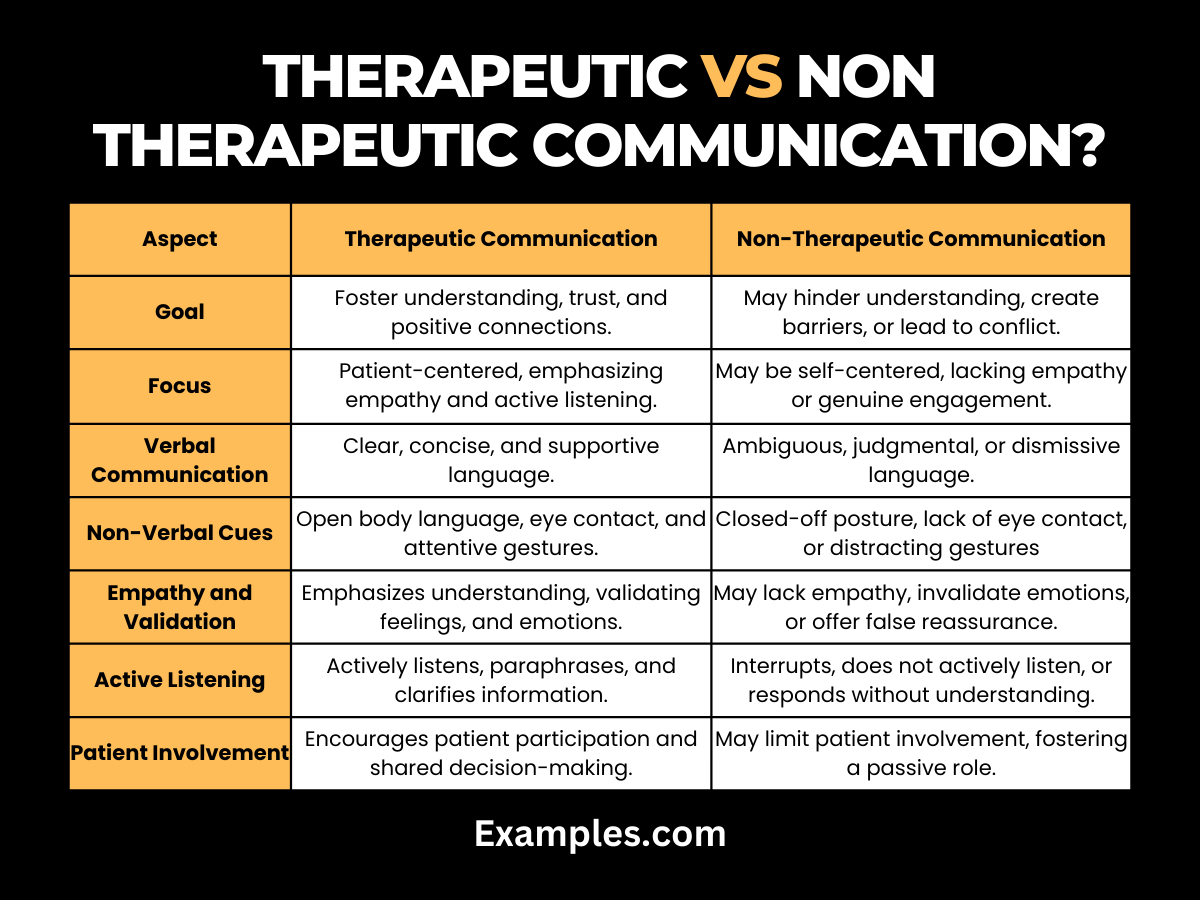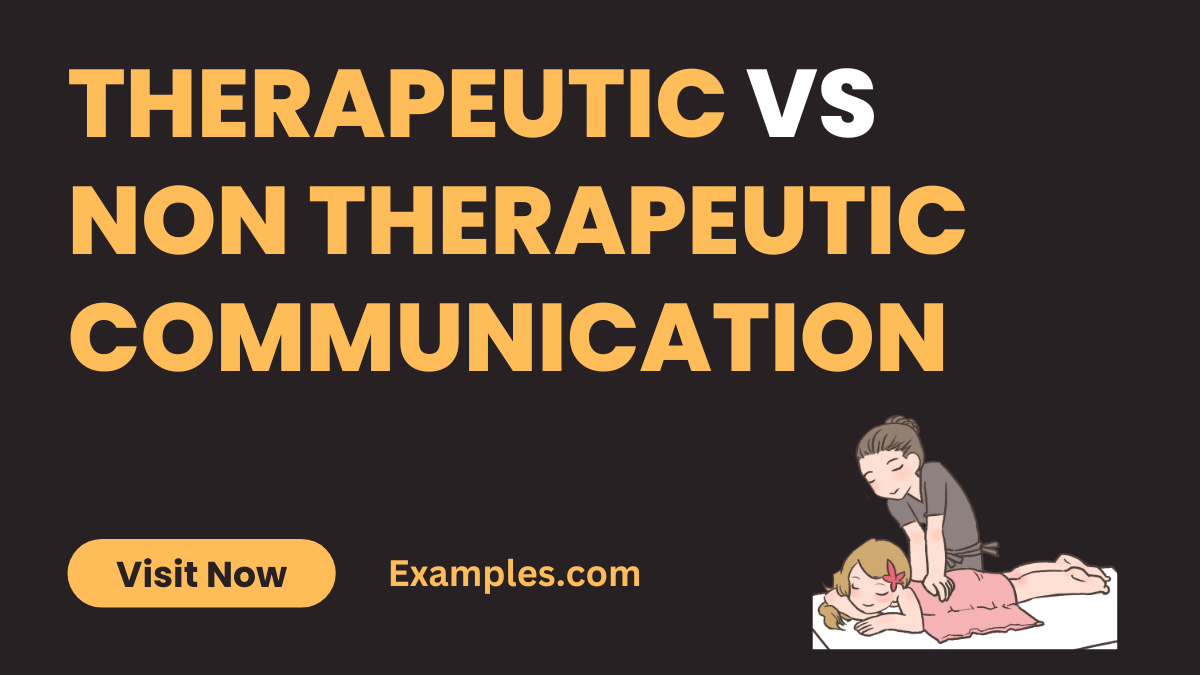Therapeutic Communication vs Non Therapeutic Communication
Unlock the nuances of Therapeutic Communication vs Non-Therapeutic Communication with our comprehensive guide. Delve into insightful examples and expert insights to master effective communication strategies. Discover the power of communication examples to enhance your understanding, incorporating key keywords seamlessly. Whether in healthcare or everyday interactions, navigate these communication styles confidently, gaining valuable skills for fostering positive connections. Elevate your interpersonal effectiveness with this in-depth exploration of Therapeutic and Non-Therapeutic Communication Examples.
What is the difference between Therapeutic Communication and Non Therapeutic Communication?

Understanding the disparities between therapeutic and non-therapeutic communication is vital for effective interpersonal interactions. Below is a detailed comparison presented in a table format:
| Aspect | Therapeutic Communication | Non-Therapeutic Communication |
|---|---|---|
| Goal | Foster understanding, trust, and positive connections. | May hinder understanding, create barriers, or lead to conflict. |
| Focus | Patient-centered, emphasizing empathy and active listening. | May be self-centered, lacking empathy or genuine engagement. |
| Verbal Communication | Clear, concise, and supportive language. | Ambiguous, judgmental, or dismissive language. |
| Non-Verbal Cues | Open body language, eye contact, and attentive gestures. | Closed-off posture, lack of eye contact, or distracting gestures. |
| Empathy and Validation | Emphasizes understanding, validating feelings, and emotions. | May lack empathy, invalidate emotions, or offer false reassurance. |
| Active Listening | Actively listens, paraphrases, and clarifies information. | Interrupts, does not actively listen, or responds without understanding. |
| Patient Involvement | Encourages patient participation and shared decision-making. | May limit patient involvement, fostering a passive role. |
| Relationship Building | Strengthens therapeutic alliances for positive outcomes. | May strain relationships, leading to mistrust or dissatisfaction. |
| Use of Silence | Utilizes purposeful silence for reflection or understanding. | Silence may be awkward, conveying disinterest or discomfort. |
| Feedback and Reflection | Provides constructive feedback, fostering growth. | Feedback may be critical without promoting constructive improvement. |
| Cultural Sensitivity | Demonstrates cultural competence and sensitivity. | May exhibit cultural insensitivity or ignorance. |
In summary, recognizing and applying therapeutic communication principles is essential for fostering positive relationships and achieving optimal outcomes in various settings.
10 Therapeutic Communication Examples
Explore these therapeutic communication examples that go beyond words, fostering understanding and empathy. Each example is carefully crafted to enhance your communication skills in various contexts.
- Active Listening: Engage fully with the speaker, providing feedback and demonstrating genuine interest. For instance, “I hear your concerns; let’s discuss how we can address them.”
- Empathetic Responses: Express understanding of others’ emotions. Say, “I can see this situation is challenging for you; I’m here to support.”
- Open-Ended Questions: Encourage comprehensive responses by asking open-ended questions. Example: “Can you share more about how you’ve been feeling lately?”
- Reflective Techniques: Use reflection to echo emotions and encourage elaboration. For example, “It seems like you’re feeling overwhelmed; tell me more about it.”
- Cultural Sensitivity: Acknowledge and respect cultural differences. Say, “I appreciate your perspective; let’s ensure our approach aligns with your cultural preferences.”
- Silence as Support: Provide space for reflection and processing. Communicate, “Take your time; I’m here whenever you’re ready to talk.”
- Validation of Feelings: Acknowledge and validate others’ emotions. For instance, “Your feelings are valid; let’s work through this together.”
- Positive Reinforcement: Recognize and appreciate positive behaviors. Say, “I noticed your efforts; your dedication is making a difference.”
- Clarification: Ensure mutual understanding through clarifying statements. Example: “Let me confirm I understand correctly; you’re saying…”
- Problem-Solving Collaboration: Collaborate on solutions to challenges. Communicate, “Let’s brainstorm together to find a solution that works for both of us.”
These therapeutic communication examples empower you to establish connections, provide support, and contribute to positive outcomes in various interpersonal interactions.
10 Non Therapeutic Communication Examples
Explore these non-therapeutic communication examples, highlighting behaviors to steer clear of in conversations. Understanding these pitfalls helps in fostering healthier and more effective communication.
- Judgmental Statements: Avoid passing judgment; opt for understanding. Instead of saying, “That’s a bad idea,” try, “I’m curious to learn more about your perspective.”
- Interrupting: Steer clear of interruptions; allow others to express themselves fully. Instead of cutting in, say, “I’m interested in hearing your thoughts; please continue.”
- Dismissive Language: Refrain from dismissive remarks; validate feelings. Instead of saying, “It’s not a big deal,” express, “I understand this is important to you.”
- Non-Verbal Distractions: Minimize distractions; focus on the conversation. Instead of checking your phone, maintain eye contact to convey attentiveness.
- Offering False Reassurance: Avoid insincere assurances; acknowledge concerns. Instead of saying, “Everything will be fine,” express, “I understand this is a challenging situation.”
- Cultural Insensitivity: Steer clear of insensitive comments; embrace diversity. Instead of making culturally inappropriate jokes, strive for inclusive language.
- Defensiveness: Refrain from becoming defensive; promote open dialogue. Instead of reacting defensively, say, “I appreciate your feedback; let’s discuss it further.”
- Blaming Language: Avoid assigning blame; focus on solutions. Instead of saying, “You caused this issue,” express, “Let’s work together to resolve the situation.”
- Closed Body Language: Minimize closed-off postures; convey openness. Instead of crossing your arms, adopt an open stance to foster a positive atmosphere.
- Ignoring Feelings: Steer clear of disregarding emotions; acknowledge feelings. Instead of ignoring someone’s distress, say, “I can see this is affecting you; let’s talk about it.”
Recognizing and avoiding these non-therapeutic communication patterns is crucial for promoting understanding, empathy, and positive connections in various interactions.
What is the Comparison between Therapeutic Communication and Non Therapeutic Communication?
Understanding the distinctions between therapeutic and non-therapeutic communication is crucial for effective interactions. Here’s a detailed comparison presented in a table format:
| Aspect | Therapeutic Communication | Non-Therapeutic Communication |
|---|---|---|
| Goal | Establish trust, understanding, and positive connections. | May hinder understanding, create barriers, or lead to conflict. |
| Focus | Patient-centered, emphasizing empathy and active listening. | May be self-centered, lacking empathy or genuine engagement. |
| Verbal Communication | Clear, concise, and supportive language. | Ambiguous, judgmental, or dismissive language. |
| Non-Verbal Cues | Open body language, eye contact, and attentive gestures. | Closed-off posture, lack of eye contact, or distracting gestures. |
| Empathy and Validation | Emphasizes understanding, validating feelings, and emotions. | May lack empathy, invalidate emotions, or offer false reassurance. |
| Active Listening | Actively listens, paraphrases, and clarifies information. | Interrupts, does not actively listen, or responds without understanding. |
| Patient Involvement | Encourages patient participation and shared decision-making. | May limit patient involvement, fostering a passive role. |
| Relationship Building | Strengthens therapeutic alliances for positive outcomes. | May strain relationships, leading to mistrust or dissatisfaction. |
| Use of Silence | Utilizes purposeful silence for reflection or understanding. | Silence may be awkward, conveying disinterest or discomfort. |
| Feedback and Reflection | Provides constructive feedback, fostering growth. | Feedback may be critical without promoting constructive improvement. |
| Cultural Sensitivity | Demonstrates cultural competence and sensitivity. | May exhibit cultural insensitivity or ignorance. |
In summary, recognizing and applying therapeutic communication principles is essential for fostering positive relationships and achieving optimal outcomes in various settings.
What is the Relationship Between Therapeutic Communication and Non Therapeutic Communication?
Examining the relationship between therapeutic and non-therapeutic communication is crucial for effective interpersonal interactions. The following table illustrates the key distinctions:
| Aspect | Therapeutic Communication | Non-Therapeutic Communication |
|---|---|---|
| Goal | Promote understanding, trust, and positive connections. | May hinder understanding, create barriers, or lead to conflict. |
| Focus | Patient-centered, emphasizing empathy and active listening. | May be self-centered, lacking empathy or genuine engagement. |
| Verbal Communication | Clear, concise, and supportive language. | Ambiguous, judgmental, or dismissive language. |
| Non-Verbal Cues | Open body language, eye contact, and attentive gestures. | Closed-off posture, lack of eye contact, or distracting gestures. |
| Empathy and Validation | Emphasizes understanding, validating feelings, and emotions. | May lack empathy, invalidate emotions, or offer false reassurance. |
| Active Listening | Actively listens, paraphrases, and clarifies information. | Interrupts, does not actively listen, or responds without understanding. |
| Patient Involvement | Encourages patient participation and shared decision-making. | May limit patient involvement, fostering a passive role. |
| Relationship Building | Strengthens therapeutic alliances for positive outcomes. | May strain relationships, leading to mistrust or dissatisfaction. |
| Use of Silence | Utilizes purposeful silence for reflection or understanding. | Silence may be awkward, conveying disinterest or discomfort. |
| Feedback and Reflection | Provides constructive feedback, fostering growth. | Feedback may be critical without promoting constructive improvement. |
| Cultural Sensitivity | Demonstrates cultural competence and sensitivity. | May exhibit cultural insensitivity or ignorance. |
Understanding the dynamics between therapeutic and non-therapeutic communication is essential for navigating various interpersonal situations and promoting positive outcomes.
Concluding the discussion on Therapeutic vs. Non-Therapeutic Communication, it’s imperative to highlight that the essence of effective communication lies in understanding and adapting these styles to suit various interpersonal situations. Therapeutic communication, centered on empathy, active listening, and patient involvement, plays a crucial role in fostering trust and building strong relationships. It is especially vital in healthcare settings but is equally important in everyday interactions. On the other hand, non-therapeutic communication, characterized by ambiguity, lack of empathy, and poor listening skills, can create barriers and conflict, impeding the development of positive connections.
For further reading on this topic, you might find the resources from the American Psychological Association (APA) insightful. They offer a wealth of information on various communication strategies and their impacts on relationships. Additionally, exploring materials from educational institutions like Harvard University’s Program on Negotiation (PON) can provide deeper insights into the nuances of communication and conflict resolution, enriching your understanding of the subject. These resources align well with the principles discussed in the article and offer high-quality, authoritative information to enhance your learning experience.



